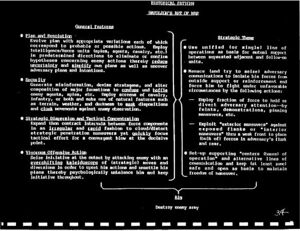Patterns of Conflict
| The works of |
| Works of John Boyd |
|---|
OODA WIKI Edition
Quantico Transcription
So what I’m laying out here in a rather detailed chart are the general features, plan and resolution, security, I’ll let you read it. You read the left side, then I’ll take you through the right side.
[long pause as audience reads the slide]
Take the top. Note what he’s doing here, all different kinds of things he’s doing. The idea is, he’s
trying to find out where his adversaries, by sending spies out, so finding, he’s eliminating possibilities. In other words, keep his own plan simple, also reduce his own uncertainty. Okay, note what he’s doing here, his idea of security. In other words, just an amorphous kind of a being, guys can’t figure out what’s going on, whole different ways he doing it. In fact, you can think of the security as being a cheng for his vigorous offensive action, being the chi.
And note this: strategic dispersion, tactical concentration. You read the literature carefully, it talks about assembling concentration. You really read between the lines, what it is, is sort of strategic dispersion followed by tactical concentration. In other words, you’re operating really wide ranges and gradually you come closer and closer, you bring your force together, and with a large force pounce upon a fraction of your adversary, is what he’s trying to do. And we’ll get into that later on.
And then vigorous offensive action. In other words, way of grabbing the initiative. So these are the kinds of things that he was doing. A strategic theme. Note what he’s talking about. Single line of operations. It doesn’t mean— unfortunately some people draw the wrong idea. Even
though it’s a single line of operation, you have people spread out laterally and also
[unintelligible] you have multiple thrusts even when they’re separated, operating as an organic whole. And also note this: in other words, try to seize that, isolate his forces so he can’t be resupplied. In other words, so we gain leverage on [unintelligible] and note the kind of thing he’s talking about here. Once again, you see it’s sort of a cheng/chi operation. Part of his force in order to tie the guy up, the other part of his force in order to pull him apart.
And his idea of setting up supporting centers of operation or depots or bases. The idea being, rather than being constricted by one line of communication, you want multiple lines of communication, so if we get sawed off from one, we’ve got other lines of communication in the field. By doing that, they— it frees up his freedom, you’ve got more freedom of maneuver than his adversary, because his adversary only has one line of communication [unintelligible].
And his aim was quite simple: to destroy an enemy army. In other words, you’re not taking out terrain, you want to take out the army. It’s a partial truth, didn’t get it all right. Remember, down in Spain, he destroyed the regular army but then the guerrillas took his people apart. So it’s not the formal forces, it’s any resistance force. Not just the formal forces. But he had a partial truth, he just didn’t recognize that terrain doesn’t fight wars. Okay.
